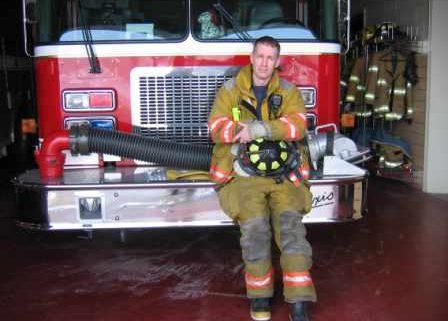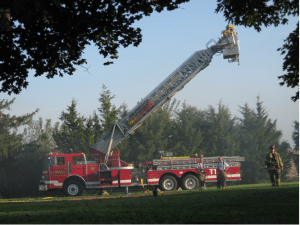Joe Collins
I’m a twelve-year veteran firefighter/paramedic in the busiest volunteer fire department in our county. I hold numerous fire and EMS certifications—many of the same as professional firefighters. My day job is as a Critical Care Paramedic in the highest call volume EMS service in Iowa.
As a firefighter, it’s annoying to hear some of the terminology used by writers and civilians—everyone seems to think that all fire apparatus they see or write about is a “fire truck.”
This is a fire truck also called an “Aerial,” “Hook and Ladder,” “Ladder” or simply a “Tower” It carries ladders, lots and lots of ladders. This particular truck, “Tower 1” besides the 105 foot hydraulic ladder with a basket, also carries ladders ranging from forty-foot to six-foot.
The “Truck Company” is responsible for searching for and rescuing victims, protecting surrounding buildings—exposures, confining the fire to keep it from spreading, helping to put out the fire, ventilation and overhaul. Ventilation is where holes are cut in the roof to release heat and smoke in the building to make rescue and knocking down the fire easier. It is one of the most dangerous and technically difficult jobs on a truck company—standing on the roof of a burning building with a chain saw cutting holes hoping that the roof doesn’t collapse under you. Overhaul means making sure that the fire is completely extinguished by pulling down walls and ceilings to make the scene “safe” so the fire investigation can begin. They also do the best they can to protect undamaged property from water and smoke. If a fire is considered too dangerous to do an interior attack, they will then dump water on it from the top—a.k.a “surround and drown” as shown in the picture below.
A truck really doesn’t carry much water, if any at all and if it needs water, it can hook up a hydrant or an engine. Ours carries 250 gallons and is primary job is to support the engine.
Some of the equipment carried on a truck which may not be carried on an engine are several types of power saws, force-able entry tools, tarps, ventilation fans, rescue tools, water vacuums, and squeegee’s.
This is a fire engine also known as a “pumper.” It is what is used most of the time to actually put out the fire—usually by doing a “Fast Attack” which is where the “Engine Company” grabs pre-connected hoses and does an interior attack to put out as much fire as they can before more water is provided by hooking into a hydrant or a water tanker arrives. Interior attack are also very dangerous and are done in dark, hot, smokey and very dangerous environments. Our “Engine 1” carries 1,500 gallons because we often work in rural areas that don’t have hydrants. City based engines often only carry five-hundred gallons of water.
The Engine Company also does search and rescue, providing water to other apparatus or the sprinkler system in the building, exposure protection, and sometimes overhaul. It also carries a great deal of hose varying from five-inch supply lines to 1-3/4 inch attack lines.
A great deal of coordination is required between the Engine Company and the Truck Company to rescue victims, quickly knock down the fire to minimize the damage to the structure and provide for the safety of firefighters and the public. In the chaos of a structure fire, none of these tasks are easy and require a high degree of training, communication and experience to make it all work smoothly.
There are also a number of other vehicles used by fire departments. In our department we have a heavy rescue/pumper, a tanker/pumper that carries three-thousand gallons of water, and two brush trucks. Other departments also have vehicles including Haz-Mat, command vehicles, rehab, technical rescue, ATV’s, ambulances, air trucks, quints and others too numerous to mention.
This is a quick overview of the subject and the functions of various fire apparatus. The names and uses often vary depending on local conventions—at our department we have a tanker, out West, it’s often called a water tender.
I am always happy to answer questions about what a fire department does and how they do it at (mfross@derbyworks.net).
Please check out our department at (http://www.eldridgefire.com/) and consider supporting your local department, professional or volunteer in whatever way you can.





